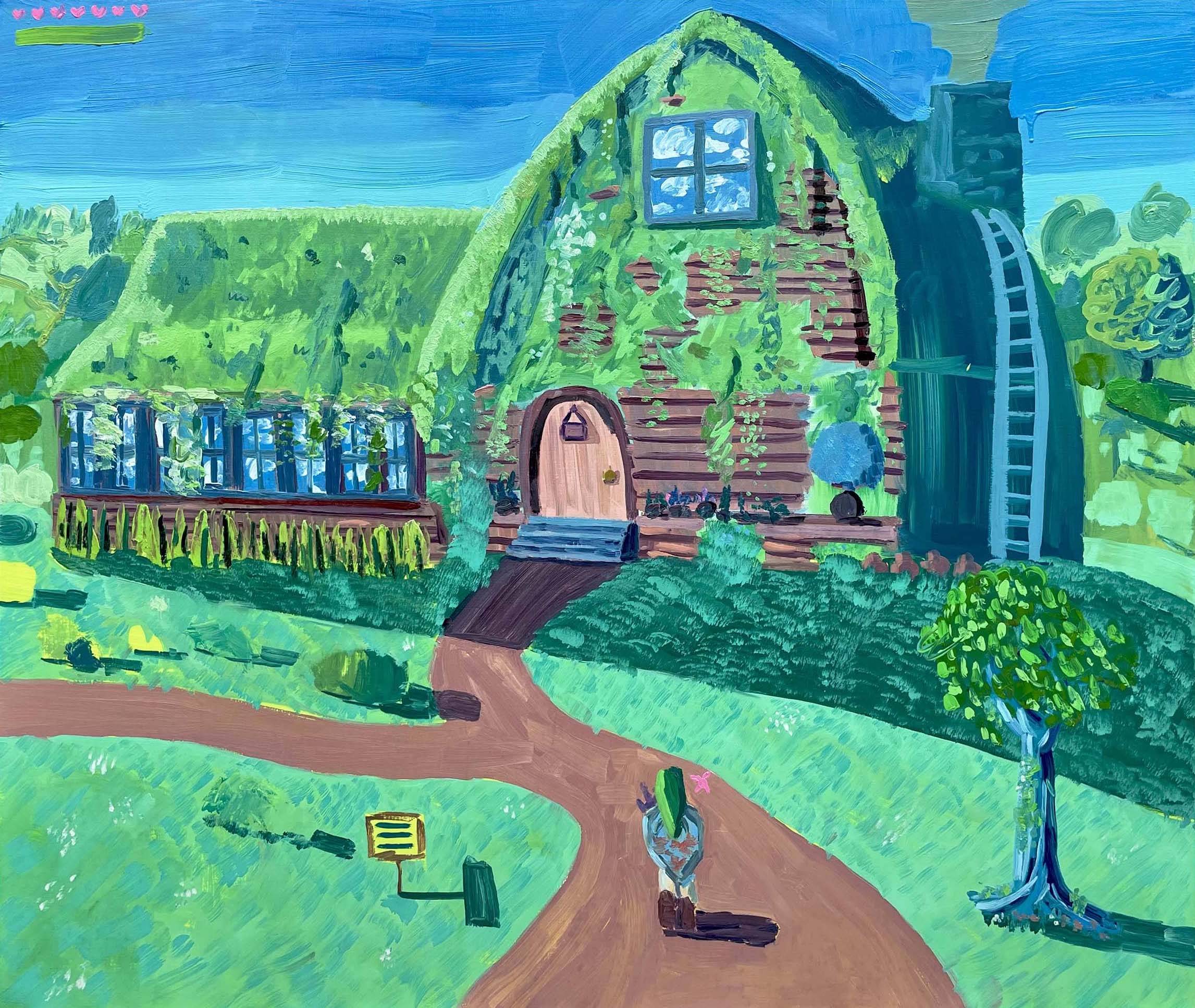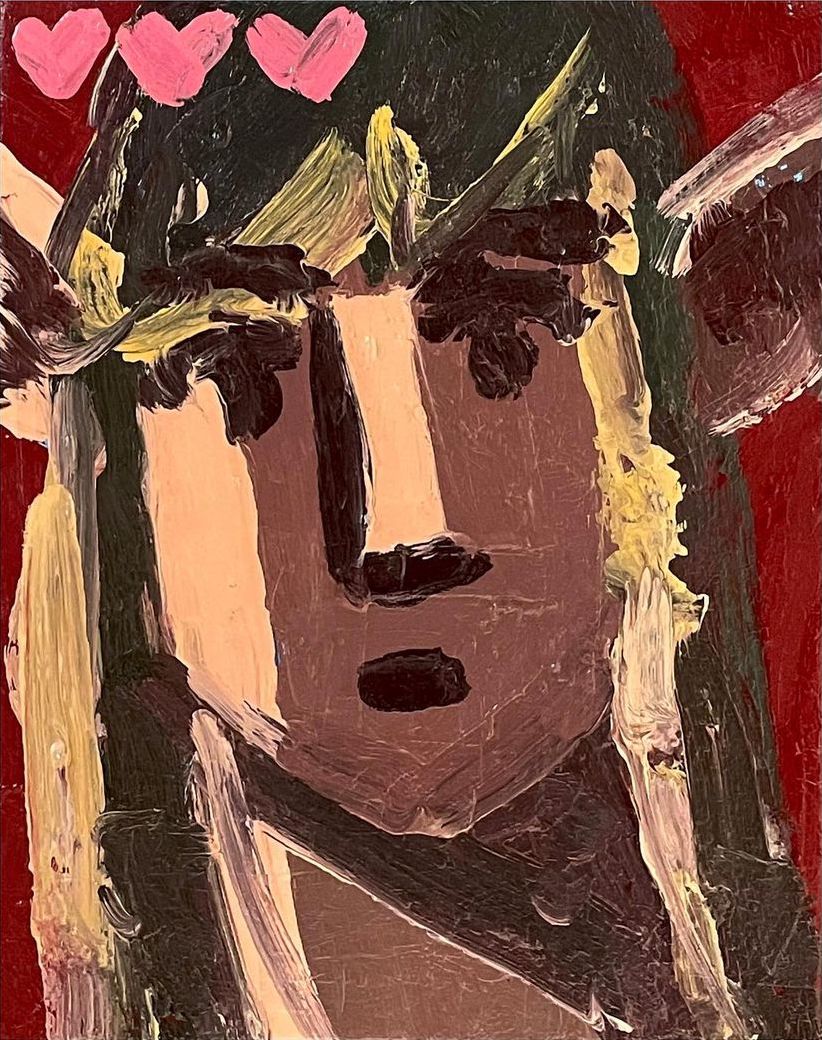ISSUE #2
JESSE MORSBERGER
INTERVIEW
Oliver Jameson
IMAGES
Jesse Morsberger

For Jesse Morsberger, creating paintings of games makes perfect sense; why wouldn't they be the subject matter of choice for a generation of artists shaped by an era of video game ubiquity?
Morsberger treats the game in-motion as a subject for a kind of interpretive still life, using a blend of observation and nostalgic wonder as a tool for closing the aesthetic gap between the literal images running on screen which serve as his model, and a vastness and depth that exists purely the mind of the individual player.

PLAYSTYLE
Tell us about your history with making art.
JESSE MORSBERGER
I received a BFA in Drawing and Painting from SUNY Purchase in 2016. I didn’t have any experience oil painting before college. I feel lucky to have learned from some really incredible artists who teach there—Sharon Horvath, Matt Bollinger and Susannah Heller to name a few. For fun growing up, I used to copy manga covers and draw comics with my dad. He had a really big collection of old school DC and Marvel comics. He was a musician and my grandfather was also a painter, so I grew up surrounded by the arts.
PS
How about your history with video games?
JM
I love video games! I wasn’t very social as a kid so I spent a lot of time alone reading fantasy novels and playing video games. I especially love Japanese Role Playing Games. Throughout middle and high school it felt so special to be able to escape into these magical worlds-to spend time getting to know unusual and memorable characters. I think video games have really helped to forge my imagination and I find that a lot of my important memories involve games.
Tell us about your history with making art.
JESSE MORSBERGER
I received a BFA in Drawing and Painting from SUNY Purchase in 2016. I didn’t have any experience oil painting before college. I feel lucky to have learned from some really incredible artists who teach there—Sharon Horvath, Matt Bollinger and Susannah Heller to name a few. For fun growing up, I used to copy manga covers and draw comics with my dad. He had a really big collection of old school DC and Marvel comics. He was a musician and my grandfather was also a painter, so I grew up surrounded by the arts.
PS
How about your history with video games?
JM
I love video games! I wasn’t very social as a kid so I spent a lot of time alone reading fantasy novels and playing video games. I especially love Japanese Role Playing Games. Throughout middle and high school it felt so special to be able to escape into these magical worlds-to spend time getting to know unusual and memorable characters. I think video games have really helped to forge my imagination and I find that a lot of my important memories involve games.

Feather Cape (2021), oil on canvas, 14 × 11 inches.
PS
The image of a nude Mario is prominent in your work. Why?
JM
I think they’re funny, but moreover I view them as self portraits. I think they’re emotionally revealing. After I painted Mario naked, it felt easier to make video game paintings with a more traditionally serious tone. Suddenly making an oil painting of a landscape from The Legend of Zelda didn’t feel as daunting.
PS
You’ve painted interpretations of a series of game covers. Could you tell us about why you’ve chosen the games you have?
JM
For those paintings, I’m choosing games that I have a connection with or stand out to me for an unusual reason. They’re observational paintings, so I have the physical game in front of me when I’m working on them—at least for the first session. Making these paintings is a good excuse to not think and just paint, work on colour relationships, light, etc.
PS
What is your relationship with streaming, another frequent subject matter?
JM
I started watching people playing games on YouTube back in 2008. It’s been really cool to watch game streaming turn into its own kind of art form with a dedicated website in Twitch. I’m a younger brother, so my older sibling often got first go at the TV growing up in our family home. I got used to watching other people play games, and I think that the experience of viewing can be just as fulfilling as playing yourself. It’s hard to match the experience of having a group of friends over late at night to play a survival horror game, but with a good streamer you can get pretty close.
The image of a nude Mario is prominent in your work. Why?
JM
I think they’re funny, but moreover I view them as self portraits. I think they’re emotionally revealing. After I painted Mario naked, it felt easier to make video game paintings with a more traditionally serious tone. Suddenly making an oil painting of a landscape from The Legend of Zelda didn’t feel as daunting.
PS
You’ve painted interpretations of a series of game covers. Could you tell us about why you’ve chosen the games you have?
JM
For those paintings, I’m choosing games that I have a connection with or stand out to me for an unusual reason. They’re observational paintings, so I have the physical game in front of me when I’m working on them—at least for the first session. Making these paintings is a good excuse to not think and just paint, work on colour relationships, light, etc.
PS
What is your relationship with streaming, another frequent subject matter?
JM
I started watching people playing games on YouTube back in 2008. It’s been really cool to watch game streaming turn into its own kind of art form with a dedicated website in Twitch. I’m a younger brother, so my older sibling often got first go at the TV growing up in our family home. I got used to watching other people play games, and I think that the experience of viewing can be just as fulfilling as playing yourself. It’s hard to match the experience of having a group of friends over late at night to play a survival horror game, but with a good streamer you can get pretty close.

PS
Which artists are important to you?
JM
To name a few: Philip Guston, Matthew Wong, Katherine Bradford, Todd Bienvenu, Dan Schein, Milton Avery, Brandon Elijah Johnson, Matt Blackwell, Anders Lindseth, Mosie Romney.
PS
What can games learn from painting? What can painting learn from games?
JM
I think the two mediums influence each other all the time. A lot of young contemporary painters subliminally draw upon gaming iconography in their work. The same goes for the games. Take a look at The Legend of Zelda: Breath of The Wild. The whole experience is like an interactive landscape painting.
Which artists are important to you?
JM
To name a few: Philip Guston, Matthew Wong, Katherine Bradford, Todd Bienvenu, Dan Schein, Milton Avery, Brandon Elijah Johnson, Matt Blackwell, Anders Lindseth, Mosie Romney.
PS
What can games learn from painting? What can painting learn from games?
JM
I think the two mediums influence each other all the time. A lot of young contemporary painters subliminally draw upon gaming iconography in their work. The same goes for the games. Take a look at The Legend of Zelda: Breath of The Wild. The whole experience is like an interactive landscape painting.

Study of Link’s Face (2021), oil on canvas, 10 × 8 inches.